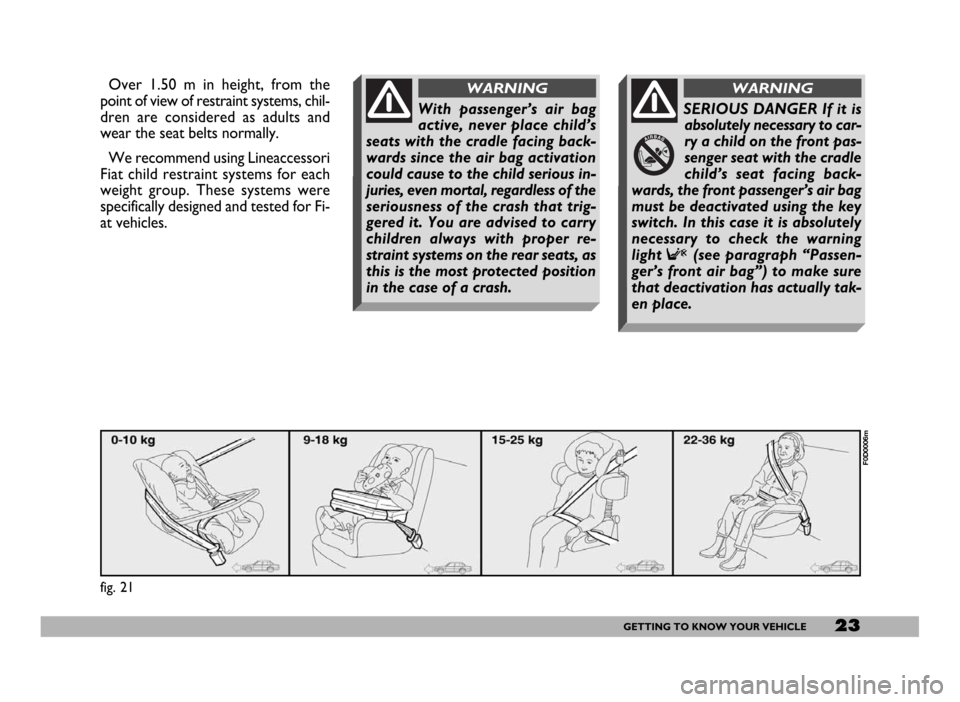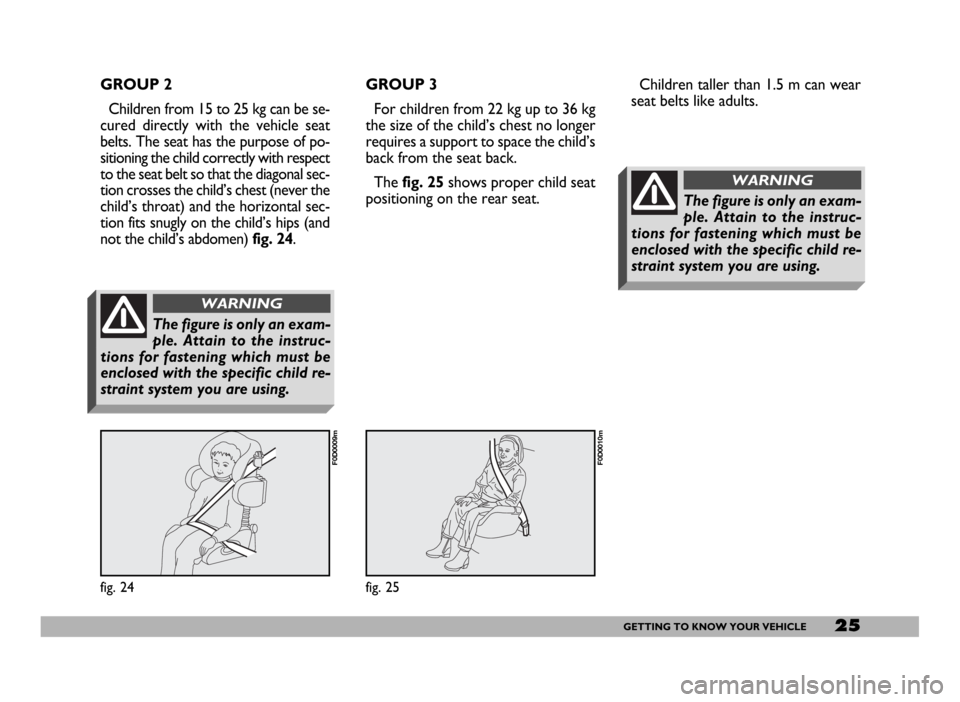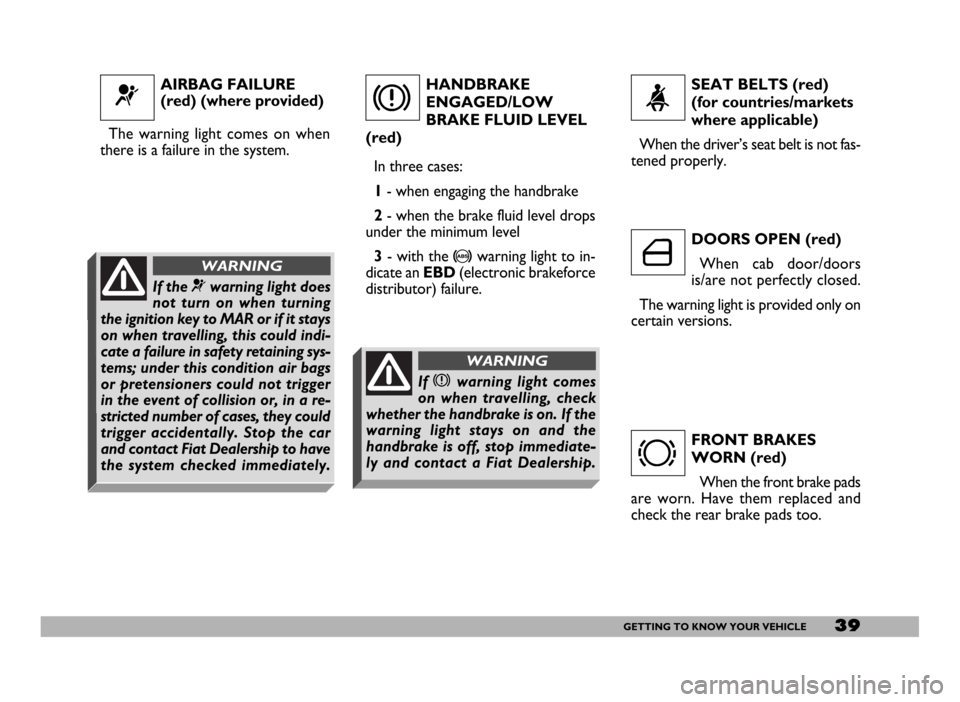Page 24 of 258

23GETTING TO KNOW YOUR VEHICLE
Over 1.50 m in height, from the
point of view of restraint systems, chil-
dren are considered as adults and
wear the seat belts normally.
We recommend using Lineaccessori
Fiat child restraint systems for each
weight group. These systems were
specifically designed and tested for Fi-
at vehicles.
fig. 21
F0D0006m
With passenger’s air bag
active, never place child’s
seats with the cradle facing back-
wards since the air bag activation
could cause to the child serious in-
juries, even mortal, regardless of the
seriousness of the crash that trig-
gered it. You are advised to carry
children always with proper re-
straint systems on the rear seats, as
this is the most protected position
in the case of a crash.
WARNING
SERIOUS DANGER If it is
absolutely necessary to car-
ry a child on the front pas-
senger seat with the cradle
child’s seat facing back-
wards, the front passenger’s air bag
must be deactivated using the key
switch. In this case it is absolutely
necessary to check the warning
light
F(see paragraph “Passen-
ger’s front air bag”) to make sure
that deactivation has actually tak-
en place.
WARNING
Page 25 of 258

24GETTING TO KNOW YOUR VEHICLE
GROUP 0 and 0+
Babies up to 13 kg must be carried
facing backwards on a cradle seat,
which, supporting the head, does not
induce stress on the neck in the event
of sharp deceleration.
The cradle is restrained by the vehi-
cle seat belts, as shown infig. 22and
in turn it must restrain the child with
its own belts.GROUP 1
Children from 9 to 18 kg are to be
seated facing forward in child seats
with front cushionfig. 23. The vehi-
cle seat belt secures both seat and
child.
fig. 22
F0D0007m
fig. 23
F0D0008m
The figure is only an exam-
ple. Attain to the instruc-
tions for fastening which must be
enclosed with the specific child re-
straint system you are using.
WARNING
The figure is only an exam-
ple. Attain to the instruc-
tions for fastening which must be
enclosed with the specific child re-
straint system you are using.
WARNING
Seats exist which are suit-
able for covering weight
groups 0 and 1 with a rear connec-
tion to the vehicle belts and their
own belts to restrain the child. Due
to their size, they can be dangerous
if installed incorrectly fastened to
the vehicle belts with a cushion.
Carefully follow the instructions for
installation provided with the seat.
WARNING
Page 26 of 258

25GETTING TO KNOW YOUR VEHICLE
GROUP 2
Children from 15 to 25 kg can be se-
cured directly with the vehicle seat
belts. The seat has the purpose of po-
sitioning the child correctly with respect
to the seat belt so that the diagonal sec-
tion crosses the child’s chest (never the
child’s throat) and the horizontal sec-
tion fits snugly on the child’s hips (and
not the child’s abdomen) fig. 24.GROUP 3
For children from 22 kg up to 36 kg
the size of the child’s chest no longer
requires a support to space the child’s
back from the seat back.
The fig. 25shows proper child seat
positioning on the rear seat.
fig. 24
F0D0009m
fig. 25
F0D0010m
The figure is only an exam-
ple. Attain to the instruc-
tions for fastening which must be
enclosed with the specific child re-
straint system you are using.
WARNING
Children taller than 1.5 m can wear
seat belts like adults.
The figure is only an exam-
ple. Attain to the instruc-
tions for fastening which must be
enclosed with the specific child re-
straint system you are using.
WARNING
Page 27 of 258
26GETTING TO KNOW YOUR VEHICLE
Group
Group Group 0, 0+
Group 1
Group 2
Group 3
Group 0, 0+
Group 1
Group 2
Group 3up to 13 kg
9 - 18 kg
15 - 25 kg
22 - 36 kg
up to 13 kg
9 - 18 kg
15 - 25 kg
22 - 36 kg
U
U
U
U
U
U
U
UU
U
U
U
U
U
U
UU
U
U
UU
U
U
U Range of weight
Range of weightSingle or two
seater
(1 or 2 passengers)
Two-seater
(1 passenger)RH side rear
passenger
Three-seater
(2 passengers)RH side rear
passengerCentral
passenger
COMBI version
PANORAMA VERSION - SHORT AND MEDIUM WHEELBASE
1st and 2nd REAR SEAT ROW
PASSENGER SEAT COMPLIANCE WITH REGULATIONS ON CHILD’S SEAT USE
Ducato complies with the new EC Directive 2000/3/CE regulating child’s seat assembling on the different vehicle seats ac-
cording to the table on next page:
Table key:
U= suitable for child restraint systems of the “Universal” category, according to European Standard ECE-R44
for the specified “Groups”
CAB
Page 28 of 258

27GETTING TO KNOW YOUR VEHICLE
IMPORTANTFor foreign markets
(Italy excluded), the cabs of vehicles
for carrying goods are suitable for fit-
ting child restraint systems of the
“Universal” category, according to Eu-
ropean Standard ECE-R44 for the tab-
ulated groups.
IMPORTANTFor Italian market
only (foreign countries excluded), the
cabs of vehicle for carrying passengers
(combi and panorama), are suitable for
fitting child restraint systems of the
“Universal” category, according to Eu-
ropean Standard ECE-R44 for the tab-
ulated groups.
Below is a summary of the rules
of safety to be followed for car-
rying children:
1) The recommended position for
installing child’s seat is on the rear seat,
as it is the most protected in the case
of a crash;2) In vehicles fitted with passenger
airbag, neverplace child’s restraint
systems on the front seat.
3) If the passenger’s airbag is deac-
tivated always check the warning light
Fon the instrument panel to make
sure that it has actually been deacti-
vated.
4) Attain to the instructions for fas-
tening the specific child restraint sys-
tem which you are using. These in-
structions must be provided by the
manufacturer. Keep the child restraint
system installation instructions with
the vehicle documents and with this
Handbook. Never use a child restraint
system without installation instruc-
tions.
5) Always check the seat belt is well
fastened by pulling the webbing.
6) Only one child is to be strapped
to each retaining system.
7) Always check the seat belts do
not fit around the child’s throat.8) While travelling, do not let the
child sit incorrectly or release the
belts.
9)Passengers should never carry
children on their laps. No-one, how-
ever strong they are, can hold a child
in the event of a crash.
10) Replace the child restraint sys-
tem after an accident.
With passenger’s air bag
active, never place child’s
seats with the cradle facing back-
wards since the air bag activation
could cause to the child serious in-
juries, even mortal, regardless of the
seriousness of the crash that trig-
gered it. You are advised to carry
children always with proper re-
straint systems on the rear seats, as
this is the most protected position
in the case of a crash.
WARNING
Page 40 of 258

39GETTING TO KNOW YOUR VEHICLE
AIRBAG FAILURE
(red) (where provided)
The warning light comes on when
there is a failure in the system.
¬
HANDBRAKE
ENGAGED/LOW
BRAKE FLUID LEVEL
(red)
In three cases:
1- when engaging the handbrake
2- when the brake fluid level drops
under the minimum level
3- with the
>warning light to in-
dicate an EBD(electronic brakeforce
distributor) failure.SEAT BELTS (red)
(for countries/markets
where applicable)
When the driver’s seat belt is not fas-
tened properly.
DOORS OPEN (red)
When cab door/doors
is/are not perfectly closed.
The warning light is provided only on
certain versions.
FRONT BRAKES
WORN (red)
When the front brake pads
are worn. Have them replaced and
check the rear brake pads too.
x<
´
d
If the ¬warning light does
not turn on when turning
the ignition key to MAR or if it stays
on when travelling, this could indi-
cate a failure in safety retaining sys-
tems; under this condition air bags
or pretensioners could not trigger
in the event of collision or, in a re-
stricted number of cases, they could
trigger accidentally. Stop the car
and contact Fiat Dealership to have
the system checked immediately.
WARNING
If xwarning light comes
on when travelling, check
whether the handbrake is on. If the
warning light stays on and the
handbrake is off, stop immediate-
ly and contact a Fiat Dealership.
WARNING
Page 43 of 258
42GETTING TO KNOW YOUR VEHICLE
Height adjustment
To raise the seat: move lever B-
fig. 46 (front seat part) or lever D-fig.
47(rear seat part) upwards and unload
your weight on the seat part to be
raised.
To lower the seat: move lever B
(front seat part) or lever D(rear seat
part) upwards and load your weight on
the seat part to be lowered.
Adjusting the reclining seat back
Turn knob C-fig. 47.
fig. 47
F0D0046m
INDIVIDUAL
SETTINGS
FRONT SEATS
Moving the seat backwards
or forwards
Lift lever A-fig. 46and push the seat
backwards or forwards.
fig. 46
F0D0045m
Only make adjustments
when the vehicle is sta-
tionary.
WARNING
Once you have released the
lever, check that the seat is
firmly locked in the runners by try-
ing to move it back and forth.
Failure to lock the seat in place
could result in the seat moving sud-
denly and dangerously.
WARNING
Page 44 of 258
43GETTING TO KNOW YOUR VEHICLE
E
fig. 48
F0D0104m
Lumbar adjustment
This feature ensures better back sup-
port.
To adjust, turn the knob E-fig. 48.
Driver’s seat warming
Press button A-fig. 49under the dri-
ver’s seat (next to handbrake lever) to
turn the seat warming off.SEAT WITH SHOCK
ABSORBER fig. 50
This seat features suspension with
mechanical springing system and hy-
draulic shock absorbers to guarantee
top comfort and safety since the
springing system enables to absorb any
shock due to bad surface roads.
This seat is fitted with height-ad-
justable armrest and head restraint.
See previous paragraph “Front seats”
for moving the seat backwards or for-
wards and for height, seat back, lum-
bar and armrest adjustment.Setting seat shock
absorbers/weight
Use the adjusting knob A-fig. 50to
set the required adjustment according
to your weight, settings range between
40 kg and 130 kg.
fig. 49
F0D0274m
F0D0279m
fig. 50